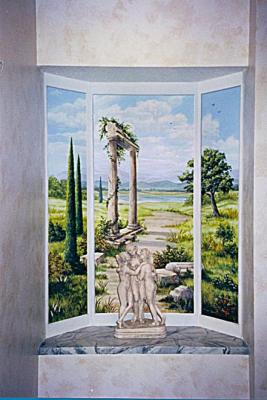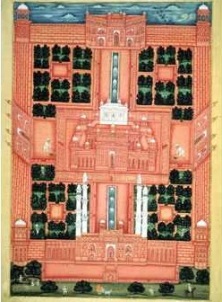What do Roman gods and goddesses, Allah, God, flowers, and dirt have in common?
They can all be part of a garden!
Since the beginning of gardens as an art form, religion has been an important aspect in the layout, purpose, and usage of gardens.
Islamic Faith
The garden is crucial for Islamic faith because it provides a paradise on earth for Muslims to practice. It is so important, in fact, that a layout of the garden is in the Koran.
Pictured is an example of the chahar bagh (“4 beds”) design used in all Islamic gardens. With the key features of this design: water—running through the center as a purifying element of the garden—and enclosed walls that were built so Muslims could practice faith without disturbances, paradise on earth was created.
Here is a more detailed explanation: http://islamic-arts.org/2011/the-symbolism-of-the-islamic-garden/
Medieval Ages
Medieval gardens were often a place of leisure, courting, romance, relaxation and more. For the monks who lived ascetic lifestyles, it was necessary for gardens to be practical and self-sufficient. Thus, they used the gardens to grow vegetables and herbs and to teach horticultural skills. Moreover, gardens in the cloister were quite religious. They were simple and often had a water source in the center, alluding to the rivers in Eden.

Eden
http://johaazen.weebly.com/ uploads/9/6/3/9/9639939/ 582437.jpg?461
In fact, the medieval garden itself could be seen as a symbol of Eden, a garden described in the Bible, and a symbol of the Virgin Mary. To honor Mary, people would build a Hortus Conclusus: an enclosed garden. Through honoring Mary, one would also be worshipping Christ. Thus, spending time in a garden provided people of the Medieval Era with a place to practice worship, much like the Islamic gardens provided for Muslims.
Roman Era
For the Romans, gardens also served as a place to worship their many gods and goddesses. Their gardens often had statues of the gods and goddesses relating to gardens, such as Pomona (goddess of fruit trees, orchards, and gardens) and Venus (goddess of love, beauty, and garden).

Pomona
https://nbarnett2.files.
wordpress.com/2010/
04/pomona-762217.jpg
Also, Roman gardens contained trompe d’oeil paintings on its walls. These paintings often depicted sacro-idllyic and religious landscapes to create the illusion of the garden extending beyond its actual dimensions. By using trompe d’oeil and statues to create such religious settings, Romans often expressed their religion and worshipped their gods and goddesses in the gardens.
Pictured below is an example of a trompe d’oeil painting. In this painting, there are three goddesses pictured before the landscape, meant to extend the view of the garden. This gave the illusion of religious presence existing everywhere around the garden.

Trompe d’oeil painting.
http://www.yvonnescustommurals.com/
resources/Window%20-%20Roman%20
Ruins.jpg.opt441x
662o0,0s441x662.jpg

